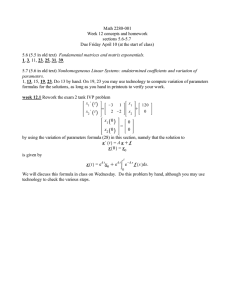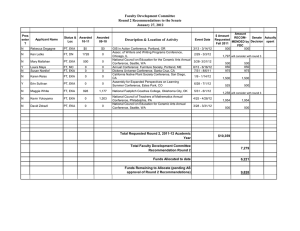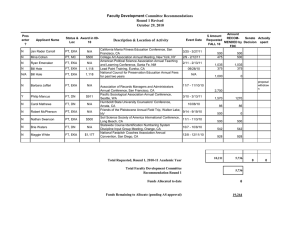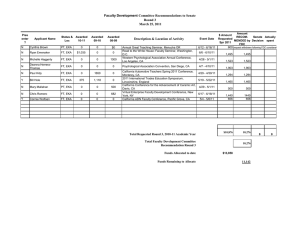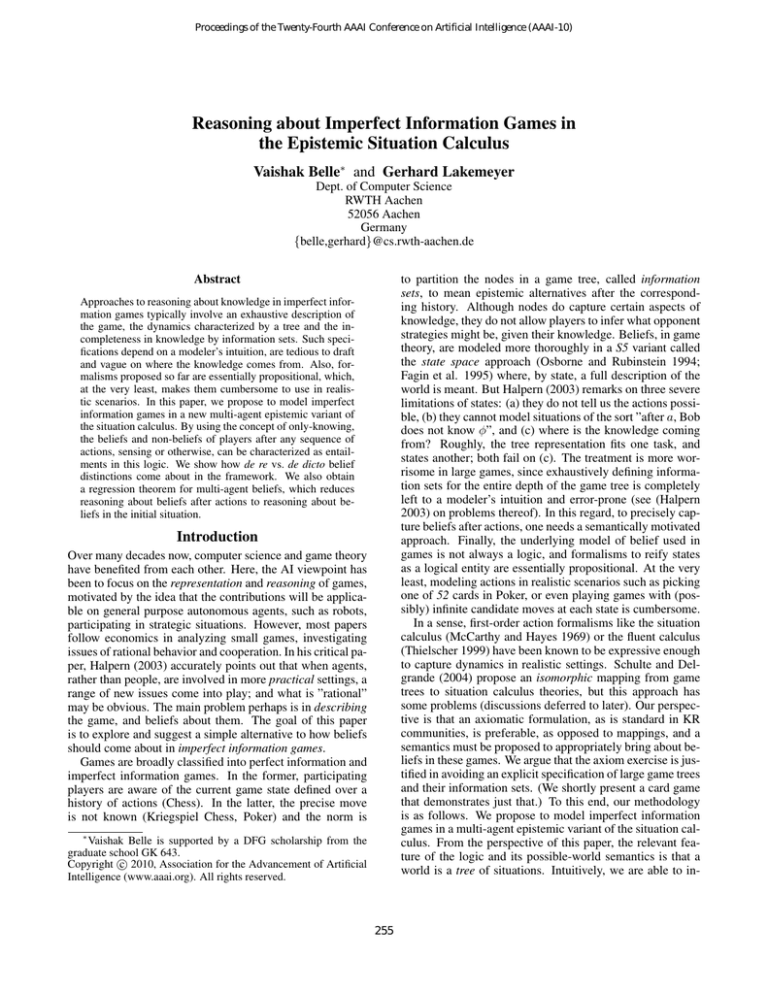
Proceedings of the Twenty-Fourth AAAI Conference on Artificial Intelligence (AAAI-10)
Reasoning about Imperfect Information Games in
the Epistemic Situation Calculus
Vaishak Belle∗ and Gerhard Lakemeyer
Dept. of Computer Science
RWTH Aachen
52056 Aachen
Germany
{belle,gerhard}@cs.rwth-aachen.de
Abstract
to partition the nodes in a game tree, called information
sets, to mean epistemic alternatives after the corresponding history. Although nodes do capture certain aspects of
knowledge, they do not allow players to infer what opponent
strategies might be, given their knowledge. Beliefs, in game
theory, are modeled more thoroughly in a S5 variant called
the state space approach (Osborne and Rubinstein 1994;
Fagin et al. 1995) where, by state, a full description of the
world is meant. But Halpern (2003) remarks on three severe
limitations of states: (a) they do not tell us the actions possible, (b) they cannot model situations of the sort ”after a, Bob
does not know φ”, and (c) where is the knowledge coming
from? Roughly, the tree representation fits one task, and
states another; both fail on (c). The treatment is more worrisome in large games, since exhaustively defining information sets for the entire depth of the game tree is completely
left to a modeler’s intuition and error-prone (see (Halpern
2003) on problems thereof). In this regard, to precisely capture beliefs after actions, one needs a semantically motivated
approach. Finally, the underlying model of belief used in
games is not always a logic, and formalisms to reify states
as a logical entity are essentially propositional. At the very
least, modeling actions in realistic scenarios such as picking
one of 52 cards in Poker, or even playing games with (possibly) infinite candidate moves at each state is cumbersome.
In a sense, first-order action formalisms like the situation
calculus (McCarthy and Hayes 1969) or the fluent calculus
(Thielscher 1999) have been known to be expressive enough
to capture dynamics in realistic settings. Schulte and Delgrande (2004) propose an isomorphic mapping from game
trees to situation calculus theories, but this approach has
some problems (discussions deferred to later). Our perspective is that an axiomatic formulation, as is standard in KR
communities, is preferable, as opposed to mappings, and a
semantics must be proposed to appropriately bring about beliefs in these games. We argue that the axiom exercise is justified in avoiding an explicit specification of large game trees
and their information sets. (We shortly present a card game
that demonstrates just that.) To this end, our methodology
is as follows. We propose to model imperfect information
games in a multi-agent epistemic variant of the situation calculus. From the perspective of this paper, the relevant feature of the logic and its possible-world semantics is that a
world is a tree of situations. Intuitively, we are able to in-
Approaches to reasoning about knowledge in imperfect information games typically involve an exhaustive description of
the game, the dynamics characterized by a tree and the incompleteness in knowledge by information sets. Such specifications depend on a modeler’s intuition, are tedious to draft
and vague on where the knowledge comes from. Also, formalisms proposed so far are essentially propositional, which,
at the very least, makes them cumbersome to use in realistic scenarios. In this paper, we propose to model imperfect
information games in a new multi-agent epistemic variant of
the situation calculus. By using the concept of only-knowing,
the beliefs and non-beliefs of players after any sequence of
actions, sensing or otherwise, can be characterized as entailments in this logic. We show how de re vs. de dicto belief
distinctions come about in the framework. We also obtain
a regression theorem for multi-agent beliefs, which reduces
reasoning about beliefs after actions to reasoning about beliefs in the initial situation.
Introduction
Over many decades now, computer science and game theory
have benefited from each other. Here, the AI viewpoint has
been to focus on the representation and reasoning of games,
motivated by the idea that the contributions will be applicable on general purpose autonomous agents, such as robots,
participating in strategic situations. However, most papers
follow economics in analyzing small games, investigating
issues of rational behavior and cooperation. In his critical paper, Halpern (2003) accurately points out that when agents,
rather than people, are involved in more practical settings, a
range of new issues come into play; and what is ”rational”
may be obvious. The main problem perhaps is in describing
the game, and beliefs about them. The goal of this paper
is to explore and suggest a simple alternative to how beliefs
should come about in imperfect information games.
Games are broadly classified into perfect information and
imperfect information games. In the former, participating
players are aware of the current game state defined over a
history of actions (Chess). In the latter, the precise move
is not known (Kriegspiel Chess, Poker) and the norm is
∗
Vaishak Belle is supported by a DFG scholarship from the
graduate school GK 643.
c 2010, Association for the Advancement of Artificial
Copyright Intelligence (www.aaai.org). All rights reserved.
255
terpret the dynamics of the game as a sequence of actions.
Thus, if a set of worlds is epistemically possible after some
history, then the player has incomplete knowledge, accounting for information sets. Strictly speaking though, worlds
are richer than reified game states, since they are not restricted only to facets about the game. This fits well with the
paradigm of Cognitive Robotics (Lakemeyer and Levesque
2007), that of autonomous agents reasoning about all sorts
of tasks, not just strategic ones. From a more representational viewpoint, we give a remedy to the issues raised by
Halpern viz. the history is maintained in the semantics (clarifying (a)), and sensing functions account for (b) and (c). We
also show in the paper that sensing functions can bring about
de re and de dicto distinctions in belief. For example, if Alice reads her card, Bob does not immediately know what her
card is, but knows that she knows.
The leverage of our machinery, to begin with, is that
atomic properties of game states after any sequence of actions can be analyzed as entailments. We lift this idea
for knowledge, by appealing to Levesque’s notion of onlyknowing.1 Briefly, Levesque introduced only-knowing to
precisely capture the beliefs of a knowledge base (KB). By
specifying the axioms that characterize the game and sentences opponents are taken to know as part of the agent’s
KB, beliefs and non-beliefs after any sequence of actions
are naturally analyzed as logical consequences of the KB.
To summarize, the resulting model allows us to study games
after arbitrary histories, all in the confines of the logic.
Entailments in our logic are made amenable to effective
reasoning with a new technical result. Regression theorems for knowledge are currently available in two flavors: in
the classical situation calculus setting (Scherl and Levesque
2003), and in a modal setting (Lakemeyer and Levesque
2004), both for one agent only. To this end, we obtain a
regression property for a rich multi-agent epistemic characterization, which allows us to reduce reasoning about beliefs
after actions to reasoning about what is known initially.
We finally remark that the semantical framework proposes for the first time a natural generalization of onlyknowing to the many agent case for a quantified language
with equality and actions. In a recent paper, we (Belle
and Lakemeyer 2010) discuss how this new notion of onlyknowing, in the static case i.e. no actions, relates to earlier
attempts (Halpern and Lakemeyer 2001). Only-knowing has
been shown to capture non-trivial nonmonotonic behavior
(Levesque 1990). So the appeal of the semantics is to have
game playing agents reason non-monotonically about the
world and such non-monotonic mechanisms in other agents.
We are organized as follows. First, we introduce the new
logic. Then, we show how knowledge about games (formulated axiomatically) is modeled and discuss a regression
property. We conclude with related work. For space reasons,
we only provide sketches for proofs.
mal and computational framework for the representation and
reasoning of actions and knowledge in the dynamic environment (McCarthy and Hayes 1969). A second-order extension forms the theoretical foundations for the agent programming language Golog (Reiter 2001). Here we follow
the relevant ideas of a reformulation of the situation calculus in a modal setting (Lakemeyer and Levesque 2004),
and extend it to the many agent case. The language is a
sorted first-order modal dialect with =, and is composed
of formulas over symbols from the following vocabulary:
first-order variables v, x, y, . . . , a countably infinite set of
standard names n1 , n2 , . . . of sort action and object, rigid
functions, rigid and fluent predicates of every arity, a distinguished fluent predicate Poss, =, and connectives ∀, ¬ and
∨. We include two types of modal operators: epistemic operators Bi and Oi for i = a, b, and modal operators for actions
[v], 2.2 Finally, distinguished fluent functions SFa and SFb
(for sensing) are the only fluent functions in the language.
For readability, the sort (action or object) of variables and
arguments of functions and predicates is left implicit. Standard names should be understood as rigid designators for all
objects and actions in the domain. As we will see, having
standard names in the language simplifies the semantics and
also enables de dicto vs. de re distinctions.
Terms are the least set of expressions formed from all
standard names, first-order variables, and if t1 , . . . , tk are
terms then so is g(t1 , . . . , tk ), where g is a k-ary function.
We call a term g(n1 , . . . , nk ) primitive if the ni are standard
names. Terms without variables are called ground terms.
The well-formed formulas (wffs) are the least set of expressions such that P (t1 , . . . , tk ) and t1 = t2 are (atomic) formulas, and [t]α, α ∨ β, ¬α, ∀x. α, 2α, Bi α, Oi α are all
formulas (where t is an action term, and α, β are formulas).
We read [t]α as ”α holds after action t”, 2α as ”α holds after
every sequence of actions”, Bi α as ”i knows α”, and Oi α
as ”all that i knows is α.” We call a formula without any free
variables a sentence. A primitive sentence is an atomic formula, say P (n1 , . . . , nk ), where the ni , are standard names.
A formulas with no 2 operators is called bounded, one without [t] or 2 is called static, and one without Bi , Oi , 2, [t],
Poss, or SFi is called a fluent formula. A formula that does
not mention any Oi operators for any i is called basic, and
one that does not mention epistemic operators at all is called
objective. Finally, we also have a notion of depth defined as:
Definition 1. The i-depth of a formula α, denoted |α|i , is
defined inductively as (Li stands for both Bi and Oi ):
1. |α|i = 1 for atomic formulas,
2. |¬α|i = |α|i , |∀x. α|i = |α|i , |[v]α|i = |α|i
3. |2α|i = |α|i , |α ∨ β|i = max(|α|i , |β|i ),
4. |Li α|i = |α|i , |Lj α|i = |α|j + 1 for j 6= i.
A formula has a depth k if max(a-depth,b-depth) = k.
For example, the formula Ba Bb Bb Ba P (x) ∧ Bb Q(x) has
a depth of 4, a a-depth of 3 and a b-depth of 4.
The Logic GL
The logic GL is a multi-agent epistemic variant of the situation calculus. The situation calculus is a first-order for-
2
For ease of exposition, only two agents Alice (a) and Bob (b)
are considered. Extensions to more agents is straightforward. Also,
other connectives, such as ∃, ∧, ≡ and ⊃ are taken for their usual
syntactic abbreviations.
1
We use the terms ”knowledge” and ”belief” interchangeably,
but allow agents to have false beliefs about the world.
256
Semantics. Here the possible-world framework, on one
hand, accounts for the dynamic changes in the world, and
on the other, provides a natural setting for only-knowing in
the many agent case. Informally, a world determines the
truth value of fluent and rigid predicates after actions, and
co-referring standard names of terms. We define a notion of
epistemic states called k-structures, built from sets of such
worlds. Formally, denoting the set of all possible finite action sequences with Z, a world w ∈ W is any function from
primitive sentences and Z to {0, 1} and from primitive terms
and Z to the standard names, and satisfying the rigidity constraint: if l is a rigid function then w[l(t1 , . . . , tk ), z] =
w[l(t1 , . . . , tk ), z 0 ] for all action sequences z, z 0 ∈ Z. |t|zw
denotes the co-referring standard name for term t, world
w and sequence z, defined as: (a) if t is a standard name
then |t|zw = t, (b) |g(t1 , . . . , tk )|zw = w[g(n1 , . . . , nk ), z],
where ni = |ti |zw .
Figure 1: The dealer (root node) gives a card each to Alice (black
node) and Bob (white node). The left branch for Alice denotes
claiming, and the right branch denotes giving in. Similarly, the left
branch for Bob denotes challenging, and the right branch denotes
conceding. Information sets are either rectangular, elliptical or dotted lines. Only Alice’s payoffs are labeled.
(The semantics for Bb and Ob are given analogously.) For
a sentence α and model eka , ejb , w, we write eka , ejb , w |= α to
mean eka , ejb , w, hi |= α. A sentence α of a, b-depth of k, j
is satisfiable iff there is a (k, j)-model eka , ejb , w such that
eka , ejb , w |= α. The formula is valid iff α is true at all (k, j)models. If Σ is any set of sentences (of maximal a, b-depth
of k, j) and α is as above, we write Σ |= α (read: Σ entails α) if for every (k, j)-model eka , ejb , w, if eka , ejb , w |= α0
for every α0 ∈ Σ then eka , ejb , w |= α. It can also be shown
that if α is valid, i.e. α is true at all (k, j)-models then it is
also true at all (k 0 , j 0 )-models, for k 0 ≥ k, j 0 ≥ j (Belle and
Lakemeyer 2010). Finally, beliefs with k-structures are easily shown to satisfy K45 properties, and the Barcan formula,
after any sequence of actions (Hughes and Cresswell 1972).
Definition 2. A k-structure (k ≥ 1), say ek , for an agent is
defined inductively as:
− e1 ⊆ W × {{}},
− ek ⊆ W × Ek−1 , where Em is the set of all m-structures.
A e1 for a, denoted e1a , is intended to represent a set of
1
worlds. A e2 is of the form {hw, e1b i, hw0 , e0 b i . . .}, and is
to be read as ”at world w, a believes b considers the worlds
1
from e1b possible but at w0 she believes b to consider e0 b
possible”. This captures the notion that a only has partial
knowledge about b, and so in different worlds, her beliefs
about what b knows differ. Intuitively, eka determines what
(and all that) is believed about the world and b, to a depth k.
We shall henceforth call a ek for Alice, a ej for Bob and
a world w as a (k, j)-model. Formulas are interpreted wrt. a
(k, j)-model iff they have a maximal a-depth of k, and a
maximal b-depth of j. The semantics for such formulas
wrt. a (k, j)-model and a sequence of actions z ∈ Z is:
Lemma 3. If α is a formula then the following are valid (wrt
models of appropriate depth):
1. 2(Bi α∧Bi (α ⊃ β) ⊃ Bi β), 2(∀x. Bi α ⊃ Bi (∀x. α))
2. 2(Bi α ⊃ Bi Bi α), 2(¬Bi α ⊃ Bi ¬Bi α)
1. eka , ejb , w, z |= P (t1 , . . . , tk ) iff w[P (n1 , . . . , nk ), z] = 1
where ni = |ti |zw ;
Reasoning about Games
2. eka , ejb , w, z |= (t1 = t2 ) iff n1 and n2 are identical where
ni = |ti |zw ;
Axioms that model a game, in general, are defined over sentences that hold initially, and sentences that define how actions behave. These axioms are Reiter-style basic action theories, but expressed as in (Lakemeyer and Levesque 2004)
using modal operators. The components of a theory Σ are:
(a) Σ0 is any set of fluent sentences; (b) Σpre is a singleton
sentence of the form 2Poss(v) ≡ π, where π is a fluent formula; (c) Σpost is a set of sentences of the form 2F (x) ≡ γ,
one for each fluent, where γ is a fluent formula; and (d)
Σsense are sentences of the form 2SFi (v) = x ≡ ϕi , for
sensing, where ϕi is a fluent formula. To account for incomplete knowledge, we will need to distinguish between what
is true in the world and what the players know. This is handled in the paper by maintaining two theories, say Σ and Ω .
To exemplify, and also motivate the need for a first-order formalism, we consider a simplified Poker variant from (Koller
and Pfeffer 1997). We propose an axiomatization, and then
consider how knowledge about games is modeled.
From a deck of three cards {J, Q, K}, a dealer gives a card
each to a and b. Player a moves first by reading her card,
and can concede (thereby ending the game and forfeiting a
3. eka , ejb , w, z |= ¬α iff eka , ejb , w, z 2 α;
4. eka , ejb , w, z |= α ∨ β iff eka , ejb , w, z |= α or eka , ejb , w, z |=
β;
5. eka , ejb , w, z |= ∀x. α iff eka , ejb , w, z |= αnx for all standard
names n of the appropriate sort;
6. eka , ejb , w, z |= [r]α iff eka , ejb , w, z · r |= α;
7. eka , ejb , w, z |= 2α iff eka , ejb , w, z · z 0 |= α for all z 0 ∈ Z.
To interpret epistemic possibilities over actions, we define
w0 'iz w (read: w0 and w agree on i’s sensing for z) inductively: (a) for z = hi, w 'iz w0 for any two worlds, (b) for
z = z 0 · r, w 'iz0 ·r w0 iff w0 'iz0 w and w[SFi (r), z 0 ] =
w0 [SFi (r), z 0 ]. Now, the semantics for Ba α and Oa α is:
8. eka , ejb , w, z |= Ba α iff for all worlds w0 'az w, for all
ek−1
, if hw0 , ek−1
i ∈ eka then eka , ek−1
, w0 , z |= α;
b
b
b
9. eka , ejb , w, z |= Oa α iff for all worlds w0 'az w,
for all ek−1
, hw0 , ek−1
i ∈ eka iff eka , ek−1
, w0 , z |= α.
b
b
b
257
will consist of 52×51 nodes for a full deck, and similarly, ⊕
will consist of 51 nodes. Moreover, the behavior of beliefs
is simple enough in this example, but if we would like to
model an action such as player 1 revealing the details of her
card only to odd numbered participants at the table, drafting information sets states is no longer immediate. On the
other hand, treating these issues with axioms in a first-order
language allows for fairly natural and, in particular, succinct
representations.
We let the union of 2-5 be Σ , the complete basic action theory while Ω denotes the union of Ω0 , Σpre , Σpost and
Σsense . They differ since Σ0 ) Ω0 . Intuitively, Ω are the
rules of the game, in the sense that they define the actions
possible and consequences, but not the cards dealt. We are
now ready to consider how epistemic reasoning of game dynamics is done.
dollar) or claiming a bet that she has a higher card. Now,
b, whose turn it is to play, reads his card. If he concedes
then he forfeits a dollar, and if he challenges a’s claim then
he forfeits $4 if a indeed has the higher card. If a’s claim
was false, then he gains an equivalent sum. Intuitively, a
(and b) initially consider all deals possible (labeled in the
figure). After a reads the card, say J, she only considers
states where Bob has K or Bob has Q (labeled ⊕). If she
bets anyway, b reads his card (not represented here), say K,
and then concludes Alice is claiming with a J or a Q (labeled
⊗), either way he has certain victory on challenging (labeled
∆). We axiomatize this game as follows:3
1. Ω0 = {carda 6= cardb , carda = J ∨ carda = Q ∨ carda =
K, cardb = J ∨ cardb = Q ∨ cardb = K, ¬Wina , R};
2. Σ0 = Ω0 ∪ {carda = J, cardb = K};
3. Σpre = {2Poss(v) ≡ true} (for simplicity);
4. Σpost = {2[v]Wina ≡ (v = yieldb ) ∨
(v = chllb ∧ carda > cardb )}
5. Σsense = {SFa (snCa ) = x ≡ carda = x,
SFb (snCa ) = x ≡ x = , . . .}
In English: we model actions beta , chllb , yielda , yieldb , snCa
and snCb to mean a (and b) betting (or challenging), conceding and sensing on the cards dealt to them. Initially, we
let constants (0-arity functions) carda and cardb denote the
cards that a and b are dealt, such that they cannot be the
same. A fluent Wina signifies a victory for a (for simplicity,
we do not go over the quantitative aspects of the payoffs).
The Poker variant is in fact a zero-sum game (Osborne and
Rubinstein 1994), such that a victory for b is taken to be
¬Wina . Also, we let R mean any set of sentences that establishes a rank ordering on the cards to allow discussions
of a ”higher” card. Formally, using 2-ary predicate > in an
infix notation, we write K > Q, K > J and Q > J (they
are taken to be standard names). Incomplete knowledge is
modeled using two initial theories, such that Ω0 decides the
basic setup, and Σ0 also specifies the precise card deal.
For simplicity, we do not place any restrictions on when
an action can be executed.4 Σpost says that if b concedes or
he challenges a with an inferior card, Wina should be made
true. The crux of the theory are the sense axioms. Roughly,
we desire a’s sensing on snCa to inform her of the standard
name that carda returns. But b’s sensing on the same action
snCa should give him no information about what card it is.
We keep a special standard name for the latter, say . It is
this feature that brings about not only de re and de dicto distinctions, but also updates what was not known before and is
now known. Sense axioms for snCb are defined analogously.
The sensing results for other actions are vacuously set to .
We remark that in realistic scenarios, the entire 52-card
deck is thrown in, and actions of a more complex type are
involved. In this sense, it is not surprising that formalisms
study simple variants. For illustration, the information set Knowledge about Games. The main idea is we specify
the theory believed at the objective level, and the theory that
a believes b to believe, to a depth k (or j). With many applications, it seems intuitive to assume players to believe that
opponents only know the rules Ω (in a fair game). Sensibly
enough, they also assume opponents to hold similar beliefs
of them. In symbols (to a depth k for a):
Oa (Ω ∧ Ob (Ω ∧ Oa ( . . . )))
(1)
To construct epistemic states about games, such as (1), we
restrict to those possible worlds that obey the rules. Let
WΩ = {w | w |= Ω }. Then we have:
Lemma 4. Let e∗ 1 = WΩ ×{{}}, and e∗ k = {hw, e∗ k−1 i|
w ∈ WΩ } be defined inductively. Then for any w0 and ek+1
,
b
0
e∗ k , ek+1
,
w
|=
(1).
b
Returning to the example, we show that all features analyzed
earlier come out naturally with the semantics. The following
entailments are of maximal a, b-depth 3, so let M be shorthand for eka , ejb , w∗ for k, j ≥ 3, where the epistemic states
are constructed as in Lem. 4 and w∗ |= Σ is the real world.
1. M |= ¬∃x. Ba (carda = x) ∧ ¬∃x. Ba ¬(carda = x)
Initially, a does not know her card (label in the figure).
2. M |= [snCa ]Ba (carda = J)
After sensing, a knows her card (label ⊕ in the figure).
3. M 6|= [snCa ]∃x. Bb (carda = x)
After a senses, b does not have de re knowledge of a’s
card.
4. M |= [snCa ]Bb ∃x. Ba (carda = x)
After a senses, b has de dicto knowledge of a’s card.
5. M |= [snCa ]Ba ¬∃x. Bb (carda = x)
a knows that her information is private, as it should be.
6. M |= [snCa ][beta ][snCb ]Bb ([chllb ]¬Wina )
After reading his card, b knows that he wins on challenging (label ∆ in the figure).
Proof (Sketches): We abbreviate and write φ(x) to mean
(carda = x). 1: Clearly, there are worlds w |= φ(J) and
w0 |= φ(Q) such that w, w0 ∈ WΩ . Since w0 'ahi w∗ ,
3
Free variables are implictly universally quantified.
For space reasons, we are terse on the particulars. In the formal
description of an extensive game, a player function is defined as a
mapping from histories to {a, b}. We could maintain fluents in Σpre
to correspond to such a function, if needed.
4
and hw0 , ek−1
i ∈ eka by construction (for some ek−1
), we
b
b
have M 6|= Ba φ(J). All other cases are analogous. 2: Following snCa , only worlds w such that w[SFa (snCa ), hi] =
258
w∗ [SFa (snCa ), hi] remain accessible for a (w 'asnCa w∗ ).
Since w∗ |= (SFa (snCa ) = J) ≡ φ(J), we have that
M, snCa |= Ba φ(J). 3: For all w ∈ WΩ , w |=
SFb (snCa ) = including w0 |= φ(Q), w0 'bsnCa w∗ . Thus,
M, snCa 6|= ∃x. Bb φ(x). 4: By an analogous argument to 2,
j
j−1 j
for every hw, ej−1
a i ∈ eb , we can show ea , eb , w, snCa |=
∃x. Ba φ(x). Intuitively, b believes a to have learnt of her
card at each world, but does not know which of these is
the real world w∗ . 5: By an analogous argument to 3, for
every hw, ek−1
i ∈ eka , we can show eka , ek−1
, w, snCa 6|=
b
b
∃x. Bb φ(x). Therefore, M, snCa |= Ba ¬∃x. Bb φ(x). We allow Σ and Ω to differ arbitrarily, and the idea is all
sentences in the scope of beliefs are interpreted wrt. Ω , and
those not in the scope of epistemic operators are interpreted
wrt. Σ . Consequently, we redefine R to mean R[Ω , Σ , z, α]
and the definition for bounded objective formulas is as discussed above, using axioms and sentences from Σ . We add:
8. R[Ω , Σ , z, SFi (v) = x] = R[Ω , Σ , z, ϕi ];
9. R[Ω , Σ , z, Ba (α)] is defined inductively on z as:
(a) R[Ω , Σ , hi, Ba α] = Ba (R[Ω , Ω , hi, α]),
(b) R[Ω , Σ , z · r, Ba α] = R[Ω , Σ , z, βrv ].
where β is the r.h.s of Thm 5. (Analogously for Bb α.) We
now discuss the main regression result.
Theorem 6. If α is a basic bounded sentence of max. a, bdepth k, j then R[Ω , Σ , hi, α] is a static sentence such that:
Σ ∧ Oa (Ω ∧ Ob (Ω . . . )) ∧ Ob (Ω . . . ) |= α iff
Σ0 ∧ Oa (Ω0 ∧ Ob ( . . . )) ∧ Ob (Ω0 . . . ) |= R[Ω , Σ , hi, α]
where, Oa (. . .) has a-depth k, and Ob (. . .) has b-depth j.
Proof (Sketch): The idea is to show that for any k-structure
such that eka , ejb , w0 |= Oa (Ω0 . . .) there is a k-structure e∗ ,
constructed inductively by replacing all worlds w in eka , at all
depths with wΩ that is exactly like w except that wΩ |= Ω .
Then e∗ , by Lem. 4, satisfies Oa (Ω . . .). Then using results from (Lakemeyer and Levesque 2004), we show that
the regression of objective formulas θ (in the scope of belief
operators) wrt. Ω is satisfied in eka iff θ is satisfied in e∗ . Recall the involved information set construction earlier, and
the intuition needed for a trivial three card imperfect information game.5 In contrast, our analysis is simple, the semantic arguments are direct, and epistemic properties richer
than those derivable from an analysis of the information sets
are shown to be regular entailments. We now show that sentences in a large fragment of the language are regressable.
Regression. An equivalent way to the entailments (1-6) is
to verify, for instance, if Oa (Ω . . .) ⊃ [snCa ]Ba (carda = J).
Reiter demonstrated that formulating fluents as successor
state axioms (SSAs) has the benefit, besides solving the
frame problem, of making logical theories amenable to a
reasoning procedure called regression. The idea is to replace fluents and the preceding action term in the sentence
with the r.h.s. of the SSAs until no more action terms are
left. The resultant regressed formula must follow from the
initial theory for the entailment to be true. Since our worlds
are defined precisely as in (Lakemeyer and Levesque 2004),
we are able to easily lift a result for regressing bounded (no
2) objective formulas. Denoting R as the regression operator, and letting z be an action sequence, Lakemeyer and
Levesque (2004) define R[z, α] (the regression of α over z)
wrt. Σ . (We skip this definition for space reasons.) In order
to extend such a regression property for knowledge, we use
the following theorem which formalizes knowledge updates
in a SSA-like form.
Intuitively, contingent on the nesting of belief operators, an
agent refers to the theory believed at the corresponding level
to evaluate the interplay between the dynamics and fluents.
This result is easily extended to a regression property that
allows theories to differ arbitrarily in depths.6 One application of such a property is when players make assumptions
on the limits of their opponent’s knowledge, and believe that
the latter’s initial knowledge is only a subset (or superset) of
what they initially believe. We remark that regression-based
reasoning as in the above theorem can be applied to the evaluation of game strategies, among other things (Osborne and
Rubinstein 1994). For example, verifying whether a strategy
is effective in enabling some goal α amounts to determining
whether α holds at the end of every candidate move by an
opponent, all from the initial situation. And owing to Thm 6,
such goals can include epistemic operators. In other words,
a can reason if her actions lead to b learning of some critical
information that would hamper her chances of victory; a relevant feature in card games that involve players exchanging
or replacing cards.
Theorem 5. |= 2[v]Bi (α) ≡ ∃x. SFi (v) = x ∧
Bi (SFi (v) = x ⊃ [v](α))
Proof (”→”): Suppose eka , ejb , w, z |= [r]Ba αrv ∧ SFa (r) =
ς for standard names r, ς. For all w0 'az·r w, if hw0 , ek−1
i∈
b
0
v
0
eka , then eka , ek−1
,
w
,
z
·
r
|=
α
.
Since
w
[z,
SF
(r)]
=
a
r
b
k k−1
0
w[z, SFa (r)], we have ea , eb , w , z |= SFa (r) = ς ⊃
[r]αrv . Thus, eka , ejb , w, z |= Ba (SFa (r) = ς ⊃ [r]αrv ).
Related Work and Conclusions
It roughly says that what will be known after an action depends on what was known and what the future looks like
contingent on sensing. Henceforth, regression instead of being relative to Σ , is defined for a pair of theories hΣ , Ω i.
This paper advocates the use of the situation calculus as an
alternate, and more expressive, representation to the extensive form, and a tool to reason about non-trivial dynamic and
epistemic properties via regression. Our general idea relies
on formulating actions in a logical framework, based on how
they change the world.
5
Game theory makes a distinction between games of imperfect
information, and incomplete information. In the latter, there is uncertainty about the payoffs. By constructing epistemic states from
worlds w |= Ω , we are modeling games of imperfect information.
If we also allowed worlds that satisfy different payoffs, it is possible to consider incomplete information games. See (Osborne and
Rubinstein 1994; Schulte and Delgrande 2004).
6
Then, R is defined wrt. k + j + 1 theories, with the k corresponding to the k-levels in a’s epistemic state, j for b’s epistemic
state and Σ . Note that the result is only applicable when onlyknowing is used at all depths.
259
with noisy actuators are some extensions. Note that, with
the latter, game trees need to account for information sets
contingent on the success/failure of actions. The difficultly
of addressing such issues is another limitation we find in
the extensive form. A version of the representation theorem
(Lakemeyer and Levesque 2004) defined for k-structures
would allow us to reduce multi-agent beliefs after actions to
non-modal first-order reasoning about the initial situation.
Our main interest lies in investigating results that compare
the compactness of first-order theories to game trees, as formalisms to represent and reason about games.
This idea of using logical approaches to reason about
information change in imperfect information games is not
new. In particular, Van Ditmarsch (2002) has proposed
epistemic extensions to dynamic logic to reason about card
games. More broadly, approaches that embed epistemic operators into Alternating-time Temporal Logic (ATL) (see
(Jamroga and Ågotnes 2007) and references therein) are
known to provide strategic operators to reason about action
paths. In the latter, it is even possible to quantify strategies in the context of belief, using meta-language notions.
But the main idea in these approaches is that the extensive
form is reified as Kripke structures, not addressing our concerns about drafting complex game trees in the first place.
It is sometimes not even clear when states are allowed to
be grouped in an information set (Halpern 2003). In our
view, beliefs should come out naturally given a set of rules.
Also note that, knowledge updates in (Van Ditmarsch 2002)
are handled using meta-theoretical Kripke frame operators,
while ours can be established semantically using functional
or truth value sensing. Finally, we believe that in many realistic settings, propositional approaches can be cumbersome.
For instance, (Jamroga and Ågotnes 2007) consider a game
where players guess codes. In general, such an action, even
for a 6-digit number requires 106 propositions, and expressing a disjunction over them in a logical framework can be
unrealistic. Also, consider the following auction scenario
involving a and b bidding alternatively, and a has a simple
strategy that she bids $2 more than b’s bid. She starts the
bid. In principle, at this stage, b’s bid can be completely
arbitrary and the game tree must contain possibly infinitely
many branches for the second move. In contrast, first-order
theories can be defined over infinite domains, and indeed,
this action is already representable in our logic.
The expressibility of the situation calculus in axiomatizing and reasoning about games is also investigated in
(Schulte and Delgrande 2004; Finzi and Lukasiewicz 2007).
While the line of work of (Finzi and Lukasiewicz 2007) is
mostly in the integration of Golog and game-theoretic planning in stochastic games, (Schulte and Delgrande 2004) are
closer to our approach. They propose two directions, an isomorphic translation from game trees to situation calculus
theories, as well as an axiomatic solution to model games,
as encouraged in this paper. However, from the epistemic
standpoint, there are some problems. Mainly, they use the
knowledge fluent from (Scherl and Levesque 2003) without
modification for a many agent framework, and this is possible because they define a partition on the set of situations
and assign it to players if it is their turn at move at the situations in the corresponding partition. The problem with a
single partition is that if it is a’s turn to move at situation s,
then b’s beliefs at s are undefined. Consequently, the only
properties we can consider at a situation are objective beliefs, and this even, only if the player is scheduled to move
at the situation. Thus, non-trivial multi-agent beliefs, and a
regression property like the one in this paper are not possible.
We intend to consider a number of directions for the future. Reasoning about the quantitative aspects of payoffs,
embedding ATL strategic operators, and modeling agents
References
Belle, V., and Lakemeyer, G. 2010. Multi-agent onlyknowing revisited. In KR. AAAI Press.
Fagin, R.; Halpern, J. Y.; Moses, Y.; and Vardi, M. Y. 1995.
Reasoning About Knowledge. The MIT Press.
Finzi, A., and Lukasiewicz, T. 2007. Game-theoretic agent
programming in Golog under partial observability. Lecture
Notes in Computer Science 4314:113.
Halpern, J., and Lakemeyer, G. 2001. Multi-agent only
knowing. Journal of Logic and Computation 11(1):41.
Halpern, J. Y. 2003. A computer scientist looks at game
theory. Games and Economic Behavior 45(1):114–131.
Hughes, G. E., and Cresswell, M. J. 1972. An introduction
to modal logic. Methuen London,.
Jamroga, W., and Ågotnes, T. 2007. Constructive knowledge: What agents can achieve under incomplete information. J. of Applied Non-Classical Logics 17(4):423–475.
Koller, D., and Pfeffer, A. 1997. Representations and solutions for game-theoretic problems. Artif. Int. 94(1):167–215.
Lakemeyer, G., and Levesque, H. J. 2004. Situations, si!
situation terms, no! In KR, 516–526.
Lakemeyer, G., and Levesque, H. 2007. Cognitive robotics.
Handbook of Knowledge Representation. Elsevier.
Levesque, H. J. 1990. All I know: a study in autoepistemic
logic. Artif. Intell. 42(2-3):263–309.
McCarthy, J., and Hayes, P. J. 1969. Some philosophical
problems from the standpoint of artificial intelligence. In
Machine Intelligence, volume 4, 463–502.
Osborne, M. J., and Rubinstein, A. 1994. A Course in Game
Theory. The MIT Press.
Reiter, R. 2001. Knowledge in action : logical foundations
for specifying and implementing dynamical systems. MIT
Press.
Scherl, R. B., and Levesque, H. J. 2003. Knowledge, action,
and the frame problem. Artif. Intell. 144(1-2):1–39.
Schulte, O., and Delgrande, J. 2004. Representing von
neumann–morgenstern games in the situation calculus. Annals of Mathematics and Artif. Intell. 42(1-3):73–101.
Thielscher, M. 1999. From situation calculus to fluent calculus: state update axioms as a solution to the inferential
frame problem. Artif. Intell. 111(1-2):277–299.
Van Ditmarsch, H. P. 2002. Descriptions of game actions.
J. of Logic, Lang. and Inf. 11(3):349–365.
260

